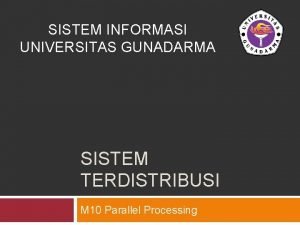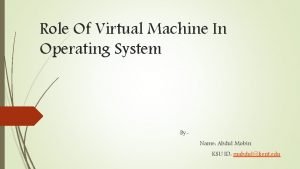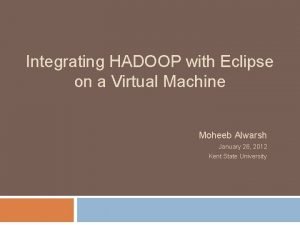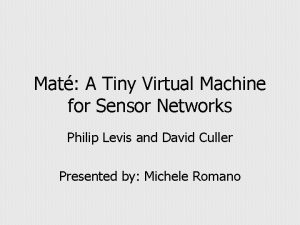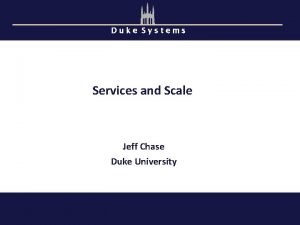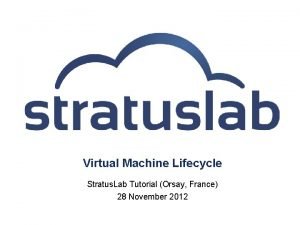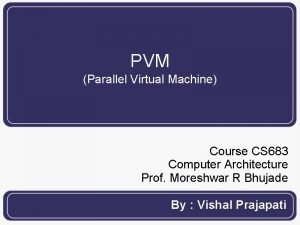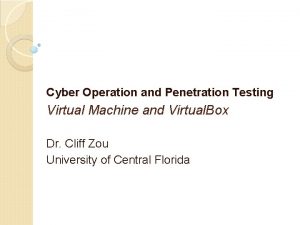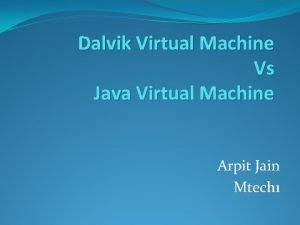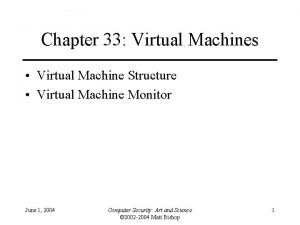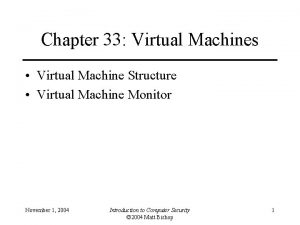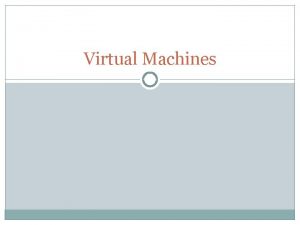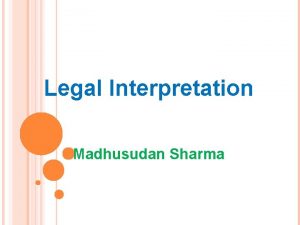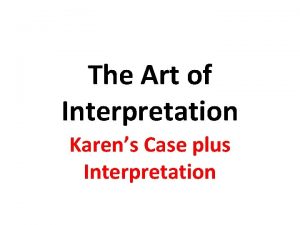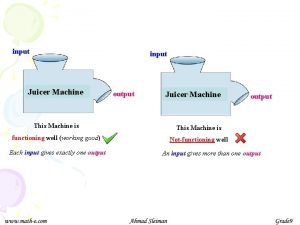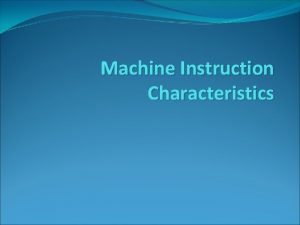4 Interpretation Overview Virtual machine interpretation Case study



















- Slides: 19

4 Interpretation § Overview § Virtual machine interpretation § Case study: SVM interpreter in Java Programming Languages 3 © 2012 David A Watt, University of Glasgow 4 -1

Overview § Recall: An S interpreter accepts code expressed in language S, and immediately executes that code. § Assume that the code to be interpreted is just a sequence of simple instructions (including conditional/unconditional jumps). § The interpreter works as follows: – First it initializes the state. – Then it repeatedly fetches, analyses, and executes the next instruction. – Executing an instruction updates the state as required. 4 -2

Virtual machine interpretation § Virtual machine code typically consists of: – load/store instructions – arithmetic/logical instructions – conditional/unconditional jumps – call/return instructions – etc. § The virtual machine state typically consists of: – storage (code, data) – registers (status, program counter, stack pointer, etc. ). 4 -3

Case study: SVM (1) § SVM (Simple Virtual Machine) will be used as a case study in this course. § SVM is suitable for executing programs in simple imperative PLs. § For a full description, see SVM Specification (available from the PL 3 Moodle page). 4 -4

Case study: SVM (2) § Source code and corresponding SVM code: p = 1; while (p < n) p = 10*p; 0: 3: 6: 9: 12: 13: 16: 19: 22: 23: 26: 29: LOADC 1 STOREG 2 LOADG 1 COMPLT JUMPF 29 LOADC 10 LOADG 2 MULT STOREG 2 JUMP 6 HALT assume that n and p are located at global addresses 1 and 2 code to evaluate ‘p < n’ code to execute ‘p = 10*p; ’ 4 -5

Case study: SVM (3) § SVM storage: – the code store is a fixed array of bytes, providing space for instructions – the data store is a fixed array of words, providing a stack to contain global and local data. § SVM main registers: – pc (program counter) points to the next instruction to be executed – sp (stack pointer) points to the top of the stack – fp (frame pointer) points to the base of the topmost frame (see § 14) – status indicates whether the programming is running, failed, or halted. 4 -6

Case study: SVM (4) § Illustration of code store: pc 0 1 2 3 4 5 6 7 8 9 10 11 12 13 14 15 4 0 1 1 0 2 0 0 1 12 18 0 29 LOADC 1 STOREG 2 LOADG 1 JUMPF 29 COMPLT … 29 30 … 16 HALT unused § Each instruction occupies 1, 2, or 3 bytes. 4 -7

Case study: SVM (5) § Illustration of data store (simplified): … sp unused sp 9 8 … 7 6 6 5 5 4 4 3 2 global data unused 3 2 1 1 0 0 stacked data global data 4 -8

Case study: SVM (6) § SVM instruction set (simplified): Op- Mnemcode onic Behaviour 6 ADD 7 SUB pop w 2; pop w 1; push (w 1+w 2) 8 MUL 9 DIV pop w 2; pop w 1; push (w 1×w 2) pop w 2; pop w 1; push (w 1–w 2) pop w 2; pop w 1; push (w 1/w 2) 10 CMPEQ pop w 2; pop w 1; push (if w 1=w 2 then 1 else 0) 11 CMPLT pop w 2; pop w 1; push (if w 1<w 2 then 1 else 0) 14 INV pop w; push (if w=0 then 1 else 0) 4 -9

Case study: SVM (7) § SVM instruction set (continued): Op- Mnemonic code Behaviour 0 LOADG d 1 STOREG d w ← word at address d; push w 4 LOADC v push v pop w; word at address d ← w 16 HALT 17 JUMP c status ← halted 18 JUMPF c 19 JUMPT c pop w; if w = 0 then pc ← c pop w; if w ≠ 0 then pc ← c 4 -10

Case study: SVM (8) § The top of the stack is used for evaluating expressions. § E. g. , evaluating (7+3)*(5 -2): LOADC 7 sp data LOADC 3 7 data ADD LOADC 5 10 data LOADC 2 5 10 data SUB MUL 3 10 data 30 data 4 -11

Writing an interpreter § Interpreters are commonly written in C or Java. § In such an interpreter: – the virtual machine state is represented by a group of variables – each instruction is executed by inspecting and/or updating the virtual machine state. 4 -12

Case study: SVM interpreter in Java (1) § Representation of instructions: final byte LOADG LOADL LOADC ADD MUL CMPEQ CMPLT INV HALT JUMPF …; = = = = = 0, 2, 4, 6, 8, 10, 12, 14, 16, 18, STOREG = STOREL = 1, 3, SUB DIV = = 7, 9, CMPGT INC JUMPT = = 13, 14, 17, 19, 4 -13

Case study: SVM interpreter in Java (2) § Representation of the virtual machine state: byte[] code; // code store int[] data; // data store int pc, cl, sp, fp, status; // registers final byte RUNNING = 0, FAILED = 1, HALTED = 2; 4 -14

Case study: SVM interpreter in Java (3) § The interpreter initializes the state, then repeatedly fetches and executes instructions: void interpret () { // Initialize the state: status = RUNNING; sp = 0; fp = 0; pc = 0; do { // Fetch the next instruction: byte opcode = code[pc++]; // Execute this instruction: … } while (status == RUNNING); } 4 -15

Case study: SVM interpreter in Java (4) § To execute an instruction, first inspect its opcode: // Execute this instruction: switch (opcode) { case LOADG: … case STOREG: … … case ADD: … case CMPLT: … … case HALT: … case JUMPT: … … } 4 -16

Case study: SVM interpreter in Java (5) § Executing arithmetic/logical instructions: case ADD: { int w 2 = data[--sp]; int w 1 = data[--sp]; data[sp++] = w 1 + w 2; break; } case CMPLT: { int w 2 = data[--sp]; int w 1 = data[--sp]; data[sp++] = (w 1 < w 2 ? 1 : 0); break; } 4 -17

Case study: SVM interpreter in Java (6) § Executing load/store instructions: case LOADG: { int d = code[pc++]<<8 | code[pc++]; data[sp++] = data[d]; fetch 2 -byte break; } operand case STOREG: { int d = code[pc++]<<8 | code[pc++]; data[d] = data[--sp]; break; } 4 -18

Case study: SVM interpreter in Java (7) § Executing jump/halt instructions: case HALT: { status = HALTED; break; } case JUMP: { int c = …; pc = c; break; } case JUMPT: { int c = …; int w = data[--sp]; if (w != 0) pc = c; break; } fetch 2 -byte operand 4 -19
 It project failure case study
It project failure case study Best worst and average case
Best worst and average case How does interpretation b differ from interpretation a
How does interpretation b differ from interpretation a Has virtual functions and accessible non-virtual destructor
Has virtual functions and accessible non-virtual destructor Microsoft virtual machine converter download
Microsoft virtual machine converter download Virtual anesthesia machine
Virtual anesthesia machine Gunadarma
Gunadarma Virtual machine history
Virtual machine history Hadoop virtualbox
Hadoop virtualbox Virtual machine windows xp download
Virtual machine windows xp download Virtual machine scale sets
Virtual machine scale sets System center - virtual machine manager
System center - virtual machine manager Tiny virtual machine
Tiny virtual machine Honeynet
Honeynet Chase virtual machine
Chase virtual machine Virtual machine life cycle
Virtual machine life cycle Pvm parallel virtual machine
Pvm parallel virtual machine Virtual pc windows 98
Virtual pc windows 98 Pentesting virtual machines
Pentesting virtual machines Virtual machine
Virtual machine






